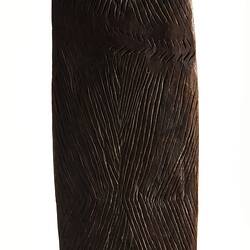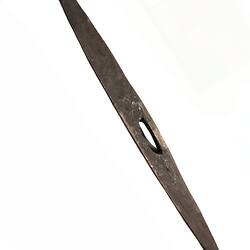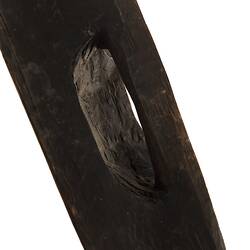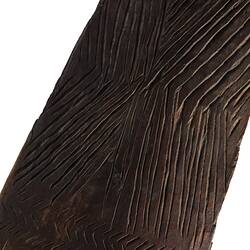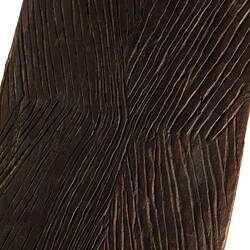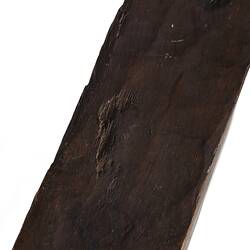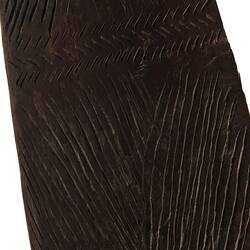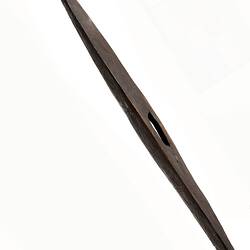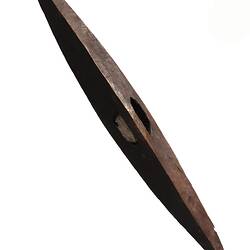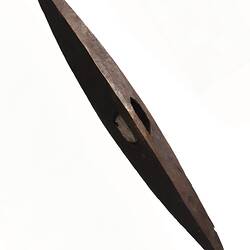Summary
The design on the front of this mulga is made from a pattern of finely engraved lines; some of these were originally filled with white pipeclay. The surface has been painted with red ochre and several rows of incised herringbone bands divide the sequences of lines.
Incised decoration on bark shields was done while the wood was raw and green, as timber hardens over time and becomes difficult to work. The intended design was often marked out in straight shallow lines and then deeply engraved with sharp tools, such as possum-tooth engravers, which were favoured in the Murray River region. The shield is left to dry before being rubbed with ochre and animal fat, which made the wood water-proof and resistant to cracking.
Local Name
Mulga
Physical Description
Elliptical shield that is triangular in cross section. The handle is carved into the solid and does not protrude from surface. The outer surface is incised with hatching. Traces of white pipe clay infilling; herringbone bands coated with red ochre across weapon. Chip out of one side.
Significance
This mulga (parrying shield) was one of the large amounts of material culture from Victoria that was taken overseas at some point in the late 19th and early 20th centuries. It came into the Museum collection in 1995 following a donation by an international collector.
It is not known exactly which Nation this mulga belongs to, only that it is from the broad Murray River Region. As with many items collected in colonial times, an overriding ignorance of the distinctiveness of Aboriginal Nations and peoples throughout Australia meant that it was rare for makers and Nations to be named or correctly attributed. Further, the damaging and incorrect idea that Aboriginal peoples were a 'dying race' also contributed to a frenzy of collecting which showed little regard for the distinctiveness of Aboriginal Nations and their cultural property. Historian Andrew Markus asserts that dying race theories were not just benign ideas, but, in fact can be seen to have catastrophically accelerated the pressures on Aboriginal peoples during these times. Markus describes the effect of the expectation of inevitable Aboriginal extinction as providing a 'rationale for actions designed to ensure that the Aborigines would indeed die out' (Andrew Markus, Governing Savages, Sydney, Allen & Unwin, 1990, p.viii).
Aboriginal people did not die out, despite the devastations of invasion and colonisation, and continue to honour and celebrate their unique cultures, cultural continuity, attachment to Country and survival.
More Information
-
Object/Medium
Shield
-
Maker
-
Locality
Specific locality unrecorded, Murray River, Victoria, Australia
-
Date Produced
-
Collector
-
Object Measurements
900 mm (Length), 140 mm (Width), 90 mm (Height)
-
Classification
-
Date Made
-
Maker
-
Clan/Language Group
-
Place Made
-
Indigenous Region
-
Keywords
-
Collection Names
-
Type of item
-
Discipline
-
Category
-
Collecting Areas

